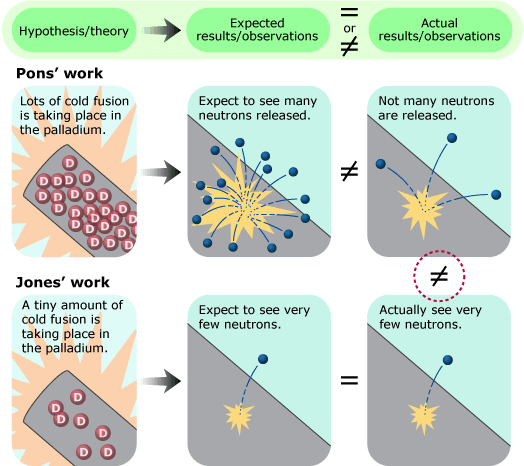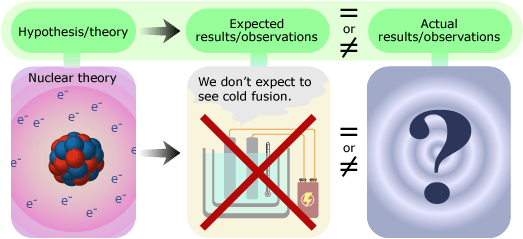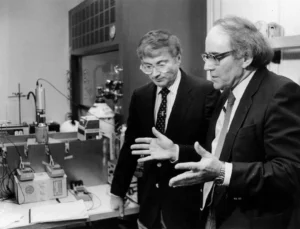Worried that Jones would scoop them, Pons rushed to perform neutron experiments of his own, but his search for neutrons did not start off well. He was initially unable to detect any sign of neutrons being released from his cold fusion cell, although the large number of neutrons produced by fusion should have been relatively easy to detect. Pons then tried a second technique for neutron detection. This time he found neutrons — but a hundred million times fewer than the number he had expected to detect! However, this was still many times more neutrons than the number that Jones had found. Nothing seemed to be matching up — Pons’ neutron results didn’t agree with his heat measurements, with Jones’ neutron results, or with established nuclear theory, which suggested no fusion should be occurring at all!

Despite their confusing results, Pons, Fleischmann, and Jones were in an exciting place. Their results conflicted with established theory — and such anomalous results sometimes lead to major scientific advances. Nuclear theory itself came about in this way, when Ernest Rutherford and his colleagues discovered that their experimental findings didn’t fit with established views of the atom. Could the surprising cold fusion results indicate that nuclear theory also needed to be reconsidered? Perhaps, but Pons, Fleischmann, and Jones would need strong evidence to support this conclusion. Such theoretical revolutions are the exceptions, not the rule. Fifty years’ worth of scientific labor and all the evidence supporting nuclear theory was telling them that they’d made a mistake; fusion couldn’t be occurring.

As scientists, the correct course of action was clear. Scientific conduct involves balancing skepticism and open-mindedness. The cold fusion scientists were expected to keep both the new results and the old theory in mind, while doing their best to gather more evidence. With such surprising results, they had an even greater responsibility to complete thorough and careful testing to support their results and eliminate the possibility of experimental error.
Though Jones, Pons, and Fleischmann knew their scientific responsibilities, there was new pressure to publish quickly since the two groups would be competing. In science, it’s not uncommon for two or more groups to investigate the same problem at the same time, and so science has a rule for assigning credit. The first group to publish gets the credit for a new discovery. Thus, if either Jones or the Pons/Fleischmann team spent too much time doing additional tests before publishing, they ran the risk of missing out on the scientific credit. Additionally, Pons and Fleischmann’s results suggested the possibility of lucrative applications for power generation — and so they were also concerned about patent rights. The standards for scientific conduct (and the time required for thorough testing) were in conflict with the time crunch compelled by other concerns.

Only two months after Pons and Fleischmann had learned that they had competition, Jones informed them that he was prepared to publish. Jones generously proposed that both groups submit their papers to the same journal at the same time so that the credit could be shared. The proposed date of submission was just 18 days away, but Pons and Fleischmann had been hoping for another 18 months to complete their testing. Despite the fact that this severely cut down on their time to gather data, Pons and Fleischmann felt they had no choice and agreed to the joint paper submission. They returned to the lab, determined to collect as much evidence as possible in the remaining days.
